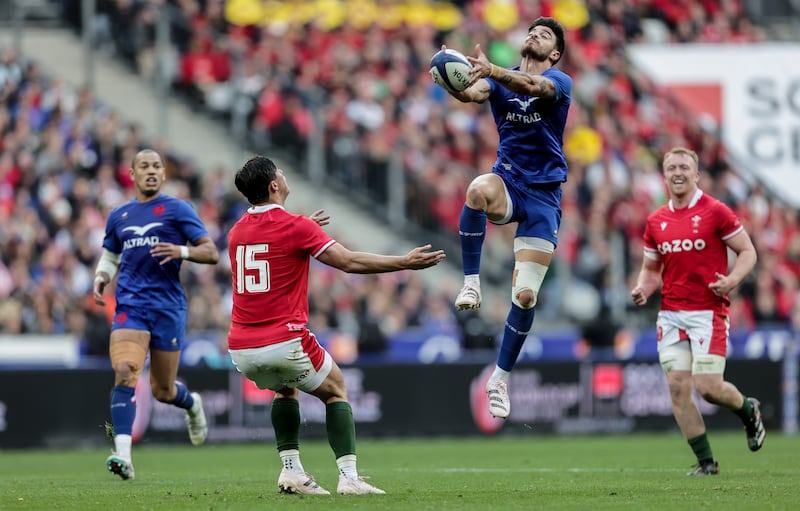It sure helped to view events unfold from this side of the Irish Sea, and one’s perspective might not be so upbeat, say, in England, Wales or Italy, but it’s hard to think of a better championship than the 2023 Six Nations.
Viewed from the cheap seats, it helped too that there hardly seemed to be a drop of rain over the five weekends and 15 matches, most of which were played in pleasant weather and on billiard tops.
Pretty much all six teams embraced the desire to entertain, with Wales joining the party in the last couple of rounds, albeit England only broke with their restricted template for one unsuccessful outing and then immediately abandoned the concept and reverted to type.
The reduction in goalkicking time and outlawing of committee meetings before lineouts helped the rhythm of games, along with generally sharp officiating. There were more tries, 91, than ever, as well as more missed tackles, more ball in play time and more offloads, helped by lower tackling.
True, pretty much every game went to form, with the higher ranked team winning all but one of the 15 matches – the exception being the unsurprising Scottish win in round one at Twickenham, after which they climbed above England.
Cue last Saturday’s memorable coronation for this Irish team and Johnny Sexton. They earned it, but you couldn’t have made it up much better. A wonderful, once-in-a-lifetime day and one-off achievement in its own right.
Invariably though, in a World Cup year, it has to be viewed in the prism of that tournament, which is fair enough from this point on. But there are reasons why only one northern hemisphere team has won it, and one of them is the end of year timing in favour of the southern hemisphere heavyweights.
They begin cranking into gear soon and will arrive in France on a roll, whereas Ireland and co go into summer storage. And, of course, the world’s top five ranked sides (including the first four in the betting) are in the same quarter of the draw.
IRELAND
A Triple Crown, a historic series win in New Zealand and now a third Grand Slam and fifth title in 15 years, this Irish team’s claim to being the best in the country’s history grows stronger with each passing milestone.
The numbers are faintly ridiculous. They’ve won 22 of their last 24 games, 12 of their last 13 in the Six Nations, and a record 14-in-a-row at home and they’ve worn the world number one ranking well.
They won each of their five games by a minimum of 13 points, were one James Ryan offload away from five bonus-point wins, have conceded less tries in the last two Six Nations than any of the other countries this year and have scored the most in the last two championships.
They also lead most other metrics – carries, metres made and line breaks – and are marginally second to France in speed of ruck ball and red zone efficiency.
Perhaps best of all, Ryan Baird came of age last Saturday, while Finlay Bealham, Tom O’Toole, Ross Byrne and Stuart McCloskey made significant contributions, and the rejuvenated Jack Conan and Conor Murray looked like Lions Test starters. It’s all good.

FRANCE
As the old 80s saying used to go, beware the French in springtime. Just when we wondered whether they might have peaked last year, Les Bleus rediscovered their mojo in the last two rounds. There were a number of factors; laying a few ghosts at Twickenham, the return of Jonathan Danty, Gregory Alldritt emulating Charles Ollivon in finding his form and Romain Ntamack doing likewise.
This coincided with Mathieu Jalibert being sidelined, which was perhaps no coincidence at all. A la that Sexton/Ronan O’Gara tug-of-war for the Irish ‘10′ jersey and how the TV cameras invariably fell on the replacement or replaced player in the stands, well, it’s much the same for French TV cameras for the gifted young French duo. A liberated Ntamack suddenly looked back to his old self.
SCOTLAND
A rare and first top-half finish since 2018 represented modest improvement, if somewhat anticlimactically so given their customary optimism and that of their media, ex-players and public. Blistering start against England and Wales, but despite lots of good rugby found it harder to break down the big two.
A tad lucky to stave off an Italian fightback but, still, the best of the rest. Gregor Townsend has unearthed the most balanced 10-12-13 axis of his tenure in the Russell-Tuipulotu-Jones combination, and bench is much stronger.
ENGLAND
A third bottom-half finish in a row. England finally discovered a sense of identity against Ireland, albeit one borne out of their embarrassing evisceration by France in a record Twickenham defeat. Ultimately their most competitive displays were based upon a very restricted kicking strategy, and their attacking game hardly evolved at all.
Their 16 line breaks and 21 offloads were each the lowest, while they conceded the most turnovers, 71. Whether Marcus Smith is the answer or not, his game time reads: 80 minutes, 8 minutes, 2 minutes, 80 minutes, 0 minutes, when an unused sub despite England needing to play catch-up. Confused? He must be.

WALES
A tough campaign for the returning Warren Gatland but performances in Rome and Paris, where they enjoyed their best carrying day and made 16 offloads, demonstrated that their attack actually developed more than England’s.
They also generated more depth than England, with Joe Hawkins, Rio Dyer, Dafydd Jenkins and others afforded plenty of game time. In the same pool as Australia and Fiji, and same quarter as England and Argentina, they can approach the World Cup more optimistically than would have seemed possible after three rounds.
ITALY
An eighth successive wooden spoon is a disappointing return after they had attacking set-pieces close to the line against France and Scotland to win both matches. They lack real composure in the red zone and while their ambition is commendable, they overplay their hand in their own 22. Hence the most possession, and the least territory. They also leaked 22 tries in total. Some of the older guard look reborn, while Ange Capuozzo, Tommaso Menoncello, Lorenzo Cannone and Michele Lamaro represent an exciting new wave.















